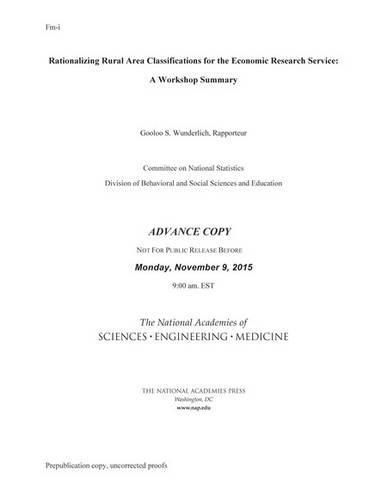Readings Newsletter
Become a Readings Member to make your shopping experience even easier.
Sign in or sign up for free!
You’re not far away from qualifying for FREE standard shipping within Australia
You’ve qualified for FREE standard shipping within Australia
The cart is loading…






The U.S. Department of Agriculture Economic Research Service (USDA/ERS) maintains four highly related but distinct geographic classification systems to designate areas by the degree to which they are rural. The original urban-rural code scheme was developed by the ERS in the 1970s. Rural America today is very different from the rural America of 1970 described in the first rural classification report.
At that time migration to cities and poverty among the people left behind was a central concern. The more rural a residence, the more likely a person was to live in poverty, and this relationship held true regardless of age or race. Since the 1970s the interstate highway system was completed and broadband was developed. Services have become more consolidated into larger centers. Some of the traditional rural industries, farming and mining, have prospered, and there has been rural amenity-based in-migration. Many major structural and economic changes have occurred during this period. These factors have resulted in a quite different rural economy and society since 1970.
In April 2015, the Committee on National Statistics convened a workshop to explore the data, estimation, and policy issues for rationalizing the multiple classifications of rural areas currently in use by the Economic Research Service (ERS). Participants aimed to help ERS make decisions regarding the generation of a county rural-urban scale for public use, taking into consideration the changed social and economic environment. This report summarizes the presentations and discussions from the workshop.
$9.00 standard shipping within Australia
FREE standard shipping within Australia for orders over $100.00
Express & International shipping calculated at checkout
The U.S. Department of Agriculture Economic Research Service (USDA/ERS) maintains four highly related but distinct geographic classification systems to designate areas by the degree to which they are rural. The original urban-rural code scheme was developed by the ERS in the 1970s. Rural America today is very different from the rural America of 1970 described in the first rural classification report.
At that time migration to cities and poverty among the people left behind was a central concern. The more rural a residence, the more likely a person was to live in poverty, and this relationship held true regardless of age or race. Since the 1970s the interstate highway system was completed and broadband was developed. Services have become more consolidated into larger centers. Some of the traditional rural industries, farming and mining, have prospered, and there has been rural amenity-based in-migration. Many major structural and economic changes have occurred during this period. These factors have resulted in a quite different rural economy and society since 1970.
In April 2015, the Committee on National Statistics convened a workshop to explore the data, estimation, and policy issues for rationalizing the multiple classifications of rural areas currently in use by the Economic Research Service (ERS). Participants aimed to help ERS make decisions regarding the generation of a county rural-urban scale for public use, taking into consideration the changed social and economic environment. This report summarizes the presentations and discussions from the workshop.